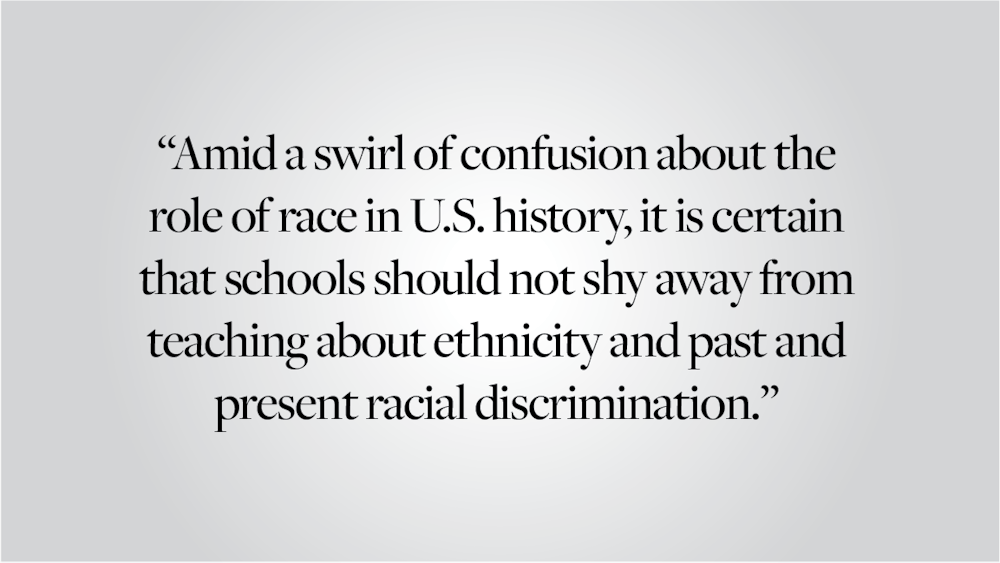Amid contentious disagreements among policymakers, teachers, parents and students about critical race theory in public K-12 schools, California Gov. Gavin Newsom signed Assembly Bill 101 in October, which will make ethnic studies a high school graduation requirement. All public school students in California are now mandated to take a one-semester course that primarily focuses on the history and struggles of four overlooked and oppressed ethnic and racial groups: Black people, Latinx people, Asian Americans and Indigenous peoples.
While widely known at the undergraduate and graduate levels, ethnic studies as a subject was relatively unfamiliar to most K-12 students and teachers prior to the passage of Assembly Bill 101. Yet, its importance cannot be overstated — everyone can benefit from taking an ethnic studies class. Thus, educators and policymakers should work towards instituting a nationwide high school ethnic studies requirement and push for greater access to these classes at the K-12 level.
Ethnic studies is a traditionally university-level concentration that studies the construction of race and ethnicity and how they intersect with power, capital and the state. It combines fields such as history, area studies, gender studies and urban studies — but stands out due to its origin in radical, student-led community organizing. In the wake of the civil rights movement and Vietnam War demonstrations in the 1960s, students of color mobilized to call for the creation of ethnic studies, a counter-narrative against the euro-centric colonialist ideology that dominated the humanities and social sciences.
In recent years, high school students and educators of color have fought for ethnic studies in a way that mirrors the 1960s student organizers who first invented the subject. Nearby, the Providence Student Union argued that although Providence high schoolers were “overwhelmingly students of color … the history they were learning failed to account for their experiences and backgrounds.” Because of this, PSU has been working to institute ethnic studies in Providence high schools. In Tucson, the teaching of Mexican American studies in a public high school sparked political debates over the constitutionality of banning ethnic studies curricula. And, as mentioned, California lawmakers recently wrote an ethnic studies mandate into state law, partly as a result of high school grassroots organizing.
Students from all backgrounds would benefit from a required ethnic studies course. For white students, it could help them gain more awareness of the ways their privilege has been constructed and learn about how they can use this privilege to protect and advocate for their peers of color. For students of color, an ethnic studies class could offer insight into their cultural and historical backgrounds, uncover false narratives told about their ethnic identities and teach them how best to fight for their own liberation.
After my experience with high school history and social studies classes that centered whiteness and provided a one-sided colonial narrative, taking an ethnic studies class here at Brown has offered me an invaluable chance to understand how my Asian American identity exists in ways that have been both destructive and liberating. I felt more validated in my confusing mess of feelings about race, whiteness and solidarity than ever before, and I learned how to work through this confusion with my peers and mentors. Instituting a nationwide ethnic studies curriculum would expose so many more students of color to such an opportunity.
Fighting for ethnic studies in K-12 schools is more crucial now than ever. Systemic racism and violence persist, but conversations about race have become more polarized than ever. Public K-12 schools, supposedly unbiased institutions dedicated to the pursuit of knowledge, have been turned into political battlegrounds over the teaching of critical race theory. Now, some groups use critical race theory as a boogeyman to oppose any discussions of race in school. But what they don’t understand is that traditional K-12 curricula are already politically and racially biased, albeit implicitly. If students are taught in history class about Manifest Destiny and Christopher Columbus, then they also deserve to learn in equal measure about the governmental genocide against Indigenous people caused by settler colonialism. If they are learning about the Founding Fathers and the Declaration of Independence, then they should also be taught about how slavery helped construct the fabric of the United States.
Amid a swirl of confusion about the role of race in U.S. history, it is certain that schools should not shy away from teaching about ethnicity and past and present racial discrimination. Not only does ethnic studies provide a more accurate, holistic reading of history, but it also offers a chance to represent, empower and support young students of color in the classroom.





